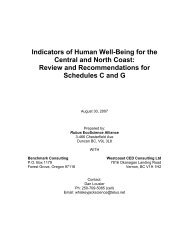Northern Plan Area Economic Opportunities and Barriers Study
Northern Plan Area Economic Opportunities and Barriers Study
Northern Plan Area Economic Opportunities and Barriers Study
You also want an ePaper? Increase the reach of your titles
YUMPU automatically turns print PDFs into web optimized ePapers that Google loves.
Summary<br />
Central Coast: L<strong>and</strong> & Coastal L<strong>and</strong> <strong>and</strong> Resource Management <strong>Plan</strong><br />
<strong>Northern</strong> <strong>Plan</strong> <strong>Area</strong><br />
<strong>Economic</strong> Development <strong>Opportunities</strong> <strong>and</strong> <strong>Barriers</strong> <strong>Study</strong><br />
Summary:<br />
The Central Coast L<strong>and</strong> & Coastal L<strong>and</strong> <strong>and</strong> Resource Management <strong>Plan</strong> is perhaps the<br />
largest <strong>and</strong> most diverse area in the province <strong>and</strong> the most controversial.<br />
The <strong>Northern</strong> <strong>Plan</strong> <strong>Area</strong> covers more than 30,000 square kilometers <strong>and</strong> has a population<br />
of roughly 5000 residents, which equates to 6 people per hectare.<br />
The area is one that has been <strong>and</strong> will continue to be rich in natural resources, a diverse<br />
<strong>and</strong> wondrous l<strong>and</strong>scape, <strong>and</strong> residents who rise to the call of the entrepreneurial spirit<br />
while working in harsh conditions. <strong>Economic</strong> development history over the past hundred<br />
years is a complicated <strong>and</strong> sad story of exploitation of resources while at the same time<br />
reducing local communities’ ability to sustain themselves. During the 1950’s <strong>and</strong> 1960’s<br />
the centralization of product development occurred in the two key industries that had<br />
sustained the communities, forestry <strong>and</strong> fishing. Job loss was extreme <strong>and</strong> unemployment<br />
rose to high levels very quickly. In the 1970’s statements were made by the BC<br />
Government that if regional development did not occur that the communities of the<br />
Central Coast would eventually fail with residents becoming unskilled <strong>and</strong> not having<br />
entry into the job market. Unemployment levels are now at the highest they have ever<br />
been in all communities with the exception of Oweekeno <strong>and</strong> Klemtu. 90% of forest<br />
related employment comes accrues to non-residents, the majority of commercial fishing<br />
boats that fish the area come from outside of the region <strong>and</strong> government related<br />
employment is now the highest employer in the region. This puts the residents of the<br />
Central Coast in a precarious position. The isolation of the area has prevented<br />
communities from developing good partnerships <strong>and</strong> tackling regional issues from a<br />
solidarity position. Better transportation <strong>and</strong> communication systems have allowed for<br />
more dialogue <strong>and</strong> information sharing to occur. All communities within the Central<br />
Coast have very similar economic development concerns, plans <strong>and</strong> a desire to be<br />
actively involved in resource management, employment <strong>and</strong> the direction of their own<br />
future.<br />
The following document has been divided into three separate units which reflect the three<br />
distinct biogeoclimatic zones of the region. Hypermaritime of the Outer Coast, Maritime<br />
of the Middle Coast <strong>and</strong> Sub-maritime of the Inner Coast. Each zone tends to have its<br />
own distinct forest cover type, plant communities, fish <strong>and</strong> wildlife, tourism attributes,<br />
water potential <strong>and</strong> mineral occurrence. Some zones have been exploited for their<br />
resources more than others have. It is evident that the highest value forests are in young<br />
regeneration <strong>and</strong> that some fish resources have either disappeared or are in serious<br />
decline. There are new untapped opportunities available that may have value to explore.<br />
3

















